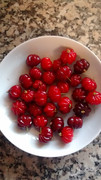Hi folks
Finnaly had the time to post something about this species
As Luc recently said, when we start colecting myrtaceas and chasing for the really rare stuff, sometimes we feel like a beginner if you speak about Pitangas... just because they are so commom and if you search online you will find many people complaining about them having a strange taste or aftertaste... diesel, terenbetine, etc... well, that is true sometimes... me too I have tasted some crap Pitangas... but it's also true that not all Pitangas are equal and some varieties are really fantastic and deserve to be praized!
So after 10 years growing several varieties of “Pitangas” I ended up selecting some trees that I consider are worth cultivating and propagating… Luc says he has been selecting Pitangas for 15 years now so I believe he too should have some gems in his hands...
Here are some photos of my favorite tree Pitanga- Eugenia uniflora ( not to be confused with the Dwarf Pitangas- Eugenia pitanga):


This tree is growing in a 30-liter pot and still it produces an abundance of fruits every year… very precocious, it started producing at 2 or 3 years of age and the curious feature is that it always produces seeded and unseeded fruits simultaneously…
When properly ripe these fruits get a “deep purple/almost black” color and the taste is fantastic… this is now one of the favorite fruits for my wife and she has always been a little finicky about my “rare fruits”.
The unseeded fruits are much smaller and apparently they ripen faster than the seeded fruits (see the pic of both fruits on my hand) and I’m finding that the birds here seem to prefer the unseeded “smaller” fruits leaving the bigger fruits for me.
Maybe the smaller fruits are just easier for birds to steal... or this is just because those smaller fruits ripen faster and are easier to harvest from the tree… but I do find that very convenient to say the least!
I'm not sure if this Pitanga belongs to the variety "dasyblasta" but I suspect so because the other confirmed "dasyblastas" I have all exibit the same behavior of having seeded and unseeded fruits in abundance, while other Pitangas have only seeded fruits.
If anyone is interested in seeds of this Pitanga I will be offering them for sale in the "Sell & Trade" section on the forum. Thanks!